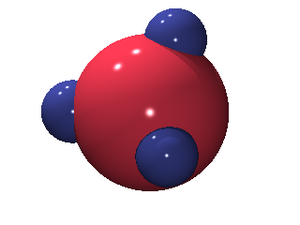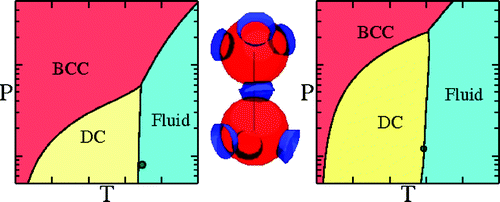Anisotropic particles with tetrahedral symmetry: Difference between revisions
Jump to navigation
Jump to search
Carl McBride (talk | contribs) m (Added another reference.) |
Carl McBride (talk | contribs) m (→References: Added a paper.) |
||
| Line 18: | Line 18: | ||
'''Related reading''' | '''Related reading''' | ||
*[http://dx.doi.org/10.1080/00268978700101051 Jiří Kolafa and Ivo Nezbeda "Monte Carlo simulations on primitive models of water and methanol", Molecular Physics '''61''' pp. 161-175 (1987)] | *[http://dx.doi.org/10.1080/00268978700101051 Jiří Kolafa and Ivo Nezbeda "Monte Carlo simulations on primitive models of water and methanol", Molecular Physics '''61''' pp. 161-175 (1987)] | ||
*[http://dx.doi.org/10.1039/b614955c Jonathan P. K. Doye, Ard A. Louis, I-Chun Lin, Lucy R. Allen, Eva G. Noya, Alex W. Wilber, Hoong Chwan Kok and Rosie Lyus "Controlling crystallization and its absence: proteins, colloids and patchy models", PCCP '''9''' pp. 2197-2205 (2007)] | |||
*[http://dx.doi.org/10.1088/0953-8984/19/32/322101 Flavio Romano, Piero Tartaglia and Francesco Sciortino "Gas–liquid phase coexistence in a tetrahedral patchy particle model", Journal of Physics: Condensed Matter '''19''' 322101 (2007)] | *[http://dx.doi.org/10.1088/0953-8984/19/32/322101 Flavio Romano, Piero Tartaglia and Francesco Sciortino "Gas–liquid phase coexistence in a tetrahedral patchy particle model", Journal of Physics: Condensed Matter '''19''' 322101 (2007)] | ||
[[category: models]] | [[category: models]] | ||
Revision as of 18:03, 22 February 2010

The phase diagram of tetrahedral patchy particles [1] exhibits the following solid phases: diamond crystal (DC), body centred cubic (BCC) and face centred cubic (FCC). The gas-liquid critical point becomes metastable with respect to the diamond crystal when the range of the interaction becomes short (roughly less than 15% of the diameter).
In contrast to isotropic models, the critical point becomes only weakly metastable with respect to the solid as the interaction range
narrows (from left to right in the figure).
See also
- PMW (primitive model for water)
References
Related reading
- Jiří Kolafa and Ivo Nezbeda "Monte Carlo simulations on primitive models of water and methanol", Molecular Physics 61 pp. 161-175 (1987)
- Jonathan P. K. Doye, Ard A. Louis, I-Chun Lin, Lucy R. Allen, Eva G. Noya, Alex W. Wilber, Hoong Chwan Kok and Rosie Lyus "Controlling crystallization and its absence: proteins, colloids and patchy models", PCCP 9 pp. 2197-2205 (2007)
- Flavio Romano, Piero Tartaglia and Francesco Sciortino "Gas–liquid phase coexistence in a tetrahedral patchy particle model", Journal of Physics: Condensed Matter 19 322101 (2007)
